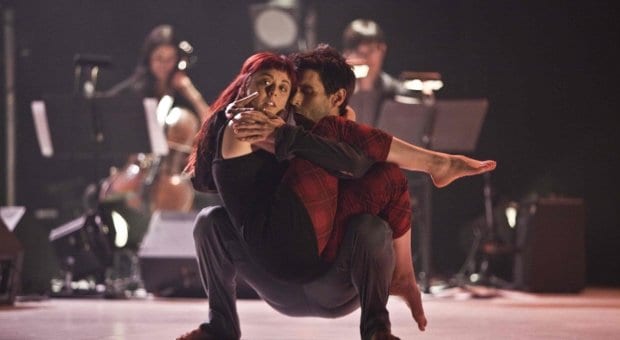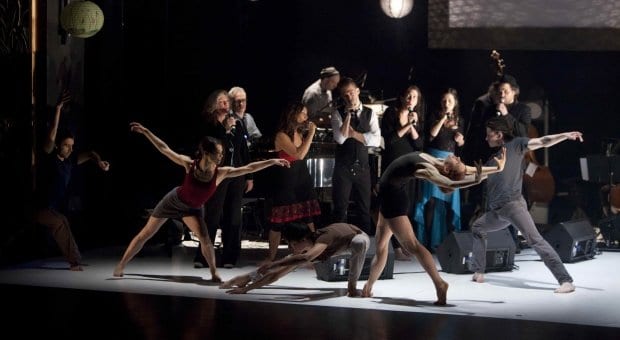
Dancers of Danse Lhasa Danse
Lhasa de Sela — singer, songwriter, Félix and Juno awards winner — has inspired so many, both before and after her death from breast cancer, that a simple one-off tribute could not do her justice. Although Montreal choreographer and director Pierre-Paul Savoie had planned to do just that, Lhasa’s spirit had other intentions.
The show Savoie created — a combination of music, film and dance — has received rave reviews and now comes to Toronto for Luminato, the first time Danse Lhasa Danse has been performed outside Quebec. Savoie talks to Xtraabout his inspiration and adoration for Lhasa and the artists that make Danse Lhasa Danse such a success.
Xtra: What inspired you to create such a multi-discipline tribute to Lhasa de Sela?
Pierre Paul Savoie: As an artist, there’s something deep that provokes you. I found that in the resonance of her music. She was witnessing humanity in a deep way. For an artist, that’s what we’re all trying to do, trying to connect with something deep and transpose it in an artistic way to give to people. I usually use movement, but what she said in words strongly related with what I feel about the world, humanity and the philosophy of life and death. I decided to make her thoughts resonate further to new generations so that they have the chance to connect with her. She’s an artist that had it all. The way of expressing herself made her someone who touched people.
Tell us about the diversity of art forms within the show.
Lhasa had different songs, like folk, pop, blues and Mexican songs. So, it was interesting to use her own diversity and put it into dance. The show has flamenco, contemporary Indian, social, contemporary and neo-classic styles of dance. It’s also a great portrait of what’s happening in Montreal. In the Toronto show, we have six singers, five musicians and 12 dancers all together. It was complex to bring these people together, but the will to honour this woman was so strong. All the artists recognized how exceptional a person she was.
Why do you think the show has been so successful?
When the show was created, it was only for one night. Now, we’re reaching the 30th representation of the show. It’s special because no words are said. It’s just her music and the dance. Nobody is speaking except Lhasa through her songs or sound clips of moments when she was speaking during performances. It’s like being in a cathedral. Some songs are lighter, but altogether, you travel inside yourself. There’s a connection with life and death. You feel someone is speaking to you during the performances. It’s quite emotional by the end. I think we were able to catch her soul and put it in that show. It looks like her, feels like her, you feel her personality. She’s there.
How do you direct artists with such different styles?
For the dancers, they were all motivated. Most of them are fans of her, using her music as warm-up to it or choreograph pieces for it. There are five musicians, and a few of them have played with Lhasa. The songs are done really differently than what Lhasa was doing, but you still recognize the essence of her music. They are creators, so I gave them the space to feel comfortable and give their best. I was still directing, but I gave them the freedom, preferring to let them go with their intuition and style and let it happen. They’re still Lhasa’s songs but in new bodies. They gave their own identity to Lhasa’s songs, with much success. Maybe 80 percent is Lhasa and the other 20 percent is what the artist has added to it.
As a Montrealer, you must be extra proud of Lhasa de Sela.
I think music was the reason why she entered Montreal. She found collaborators in a city that had the creativity and challenges. Half her life was in Montreal, where she found her own and settled. In the Mile End neighbourhood she felt secure, challenged and nourished as an artist. She’s a model of someone from another language who comes to the city and makes their place, a model of integration. In the French community, she was adored, even though she just wrote three songs in French. But she was really ready to exchange with the community.
Are you excited about presenting the show in Toronto for the first time?
It’s the first time it will be outdoors. The stars are great, and I’m quite confident that we’ll make an unusual show for outside. There’s a danger that we could get lost in the space, but because she speaks a lot about space, like in her song “Soon This Space Will Be Too Small,” it fits really well. The force of her words will carry and her material will live. It’s rare that we take a big crowd into this level of intimacy with her repertoire, but it will happen even with so many people there. It will be a great prayer altogether about being human, being alive and passing through life. Through the resonance of her work, Lhasa was adored for her integrity, authenticity and her philosophical way of thinking. She was a true person, which is rare in show business.
Danse Lhasa Danse
Wed, June 19, 9pm
David Pecaut Square, 55 John St
Free

 Why you can trust Xtra
Why you can trust Xtra


